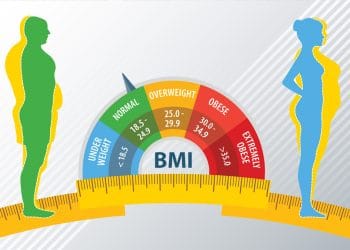If you go to the doctor for a health check, they’ll probably weigh and measure you. From these results, they can then calculate something called your Body Mass Index, or BMI for short. BMI is used to determine if you are under or overweight for your height.
Unfortunately, BMI is not especially reliable, especially for exercisers, as muscle is denser than fat, and BMI doesn’t account for body composition. So, for example, you could be a muscular 220-pound bodybuilder with a body fat percentage of 10-12 and still be deemed unhealthy because your BMI comes out high.
A more reliable indicator is your waist-to-height ratio (1). That’s because fat stored around your abdomen is considered to be the most dangerous type of fat.
Use our Waist-to-Height calculator to see if you need to lose abdominal fat and lower your risk of illness and disease.
Waist-to-Height (WHtR) Calculator
What is Your Waist-to-Height Ratio?
Your waist-to-height ratio is the relationship between your waist circumference and your height. The smaller your waist measurement is, the more favorable the ratio will be.
It’s often said that to be healthy, a man’s waist measurement should be less than 37 inches and below 31.5 inches for women. But these guidelines do not consider that taller people often have naturally wider waists, even when they are lean.
Level Up Your Fitness: Join our 💪 strong community in Fitness Volt Newsletter. Get daily inspiration, expert-backed workouts, nutrition tips, the latest in strength sports, and the support you need to reach your goals. Subscribe for free!
Our waist-to-height calculator allows for a more accurate assessment of body shape, composition, and waist circumference.
While your body stores fat all over, many people tend to accumulate fat around their abdomen. Also known as visceral fat, this is arguably the most dangerous place to store fat because it can affect the health and function of the organs within the abdominal cavity.
Too much abdominal fat is linked to (2):
- Heart disease
- Hypertension
- Type II diabetes
- Gallbladder disease
- Pancreatitis
- Cancer
- Osteoarthritis
- Sleep apnea
- Chronic disability
To make matters worse, abdominal fat will also obscure your abs, even if you are lean everywhere else. A lot of exercisers have no problem revealing the top part of their abs and show an impressive two or even a four-pack. But if you want six-pack or even eight-pack abs, that belly fat has GOT to go!
How is Waist-to-Height Ratio Calculated?
The waist-to-height ratio is very easy to calculate. Simply take your waist circumference and divide it by your height.
For example:
If your waist measurement is 32 inches and your height is 72 inches, your waist-to-height ratio would be 0.44 (32 divided by 72).
The ideal average waist-to-height ratio is less than 0.5. However, there are also rankings for lower and higher scores, as you’ll see below.
- Waist circumference = 92 cm;
- Height = 182 cm;
- All you need to put these values into the formula that is:
- WHtR = ( Waist circumference / Height )
- = 92 / 182
- WHtR = 0.51
As easy as determining your waist-to-height ratio is, there is no need to do it yourself. Just use our calculator!
How To Use The Waist-to-Height Calculator
Our waist-to-height calculator is very straightforward to use. Just follow these steps:
- Choose your preferred units – imperial (feet, inches) or metric (meters, centimeters).
- Enter your height.
- Measure horizontally around your navel or belly button for your waistline. You may find it easier to have a friend or family member take this measurement for you.
- Enter your waist measurement.
- Hit “Calculate“.
- Your results will be displayed as a ratio in the box below.
Interpreting your Results
So, how does your waist-to-height ratio measure up? Compare your score to the chart below:
| Classification | Adult women | Adult men | Children <15 years |
| Extremely slim | ≤ 0.34 | ≤ 0.34 | ≤ 0.34 |
| Slim | 0.35 – 0.41 | 0.35 – 0.42 | 0.35 – 0.45 |
| Healthy | 0.42 – 0.48 | 0.43 – 0.52 | 0.46 – 0.51 |
| Overweight | 0.49 – 0.53 | 0.53 – 0.57 | 0.52 – 0.63 |
| Very overweight | 0.54 – 0.57 | 0.58 – 0.62 | – |
| Obese | ≥ 0.58 | ≥ 0.63 | ≥ 0.64 |
It’s generally accepted by the medical community that a waist-to-height ratio greater than 0.5 increases your risk of cardiovascular disease and a host of other health problems, including several cancers (3).
Waist-to-Height Ratio Charts
Using waist-to-height ratios, body status can be classified as follows:
WHtR Waist-to-Height Ratio Chart for Men
| Health Classification | WHtR Value |
| Extremely Slim | 0.34 and below |
| Slim | 0.35 to 0.42 |
| Healthy | 0.43 to 0.52 |
| Overweight | 0.53 to 0.57 |
| Highly Overweight | 0.58 to 0.62 |
| Obese | 0.63 and above |
WHtR Waist-to-Height Ratio Chart for Women
| Health Classification | WHtR Value |
| Extremely Slim | 0.34 and below |
| Slim | 0.42 to 0.48 |
| Healthy | 0.42 to 0.48 |
| Overweight | 0.49 to 0.53 |
| Highly Overweight | 0.54 to 0.57 |
| Obese | 0.58 and above |
WHtR Waist-to-Height Ratio Chart for Children <15 years
| Health Classification | WHtR Value |
| Extremely Slim | 0.34 and below |
| Slim | 0.35 – 0.45 |
| Healthy | 0.46 – 0.51 |
| Overweight | 0.52 – 0.63 |
| Highly Overweight | – |
| Obese | 0.64 and above |
How to Improve Your Waist-to-Height Ratio
Getting taller will automatically lead to a better waist-to-height ratio, but that is not practical or even possible!
So, that leaves reducing waist size by losing body fat. Unfortunately, it’s impossible to specifically target visceral or abdominal fat, so you’ll need to lose fat from all over your body to whittle down your waist size.
Practical strategies for losing body fat include:
1. Create a calorie deficit
To lose fat, you need to create a calorie deficit. This means eating fewer (usually around 500 less) calories than your body actually needs, which will force your body to burn stored fat for fuel.
If you aren’t tracking your food intake, you are just guessing when it comes to creating a calorie deficit. You need to know how much you are eating to make the necessary adjustments to your food intake.
Level Up Your Fitness: Join our 💪 strong community in Fitness Volt Newsletter. Get daily inspiration, expert-backed workouts, nutrition tips, the latest in strength sports, and the support you need to reach your goals. Subscribe for free!
Use our calorie deficit calculator to determine how much you should be eating and then a nutrition analysis app to make sure you are hitting your goals.
2. Increase your energy expenditure
While you can burn fat and lose weight without exercise, you’ll make faster progress if you commit to working out several days a week. Exercise burns calories and will deepen your calorie deficit for better results. Plus, combining exercise with a sensible diet means you won’t have to starve yourself to shed those unwanted pounds.
Both strength training and cardio are valuable for weight loss and fat burning. Strength training will preserve your existing muscle mass and improve nutrient partitioning and insulin sensitivity. At the same time, cardio is good for burning calories and fat. So, do both to lose fat as quickly and comfortably as possible.
3. Get more sleep
Too little sleep can interfere with fat burning and muscle building. Sleep deprivation is linked to increased sugar and carb cravings, and less motivation for exercise. It could also increase insulin resistance, which is linked to abdominal fat storage.
Try to get at least eight hours of sleep per night. This may mean you need to go to bed earlier, but that’s the price you must pay if you want to build muscle and lose fat.
4. Cut down on the booze
Heavy drinkers often have what is commonly called a beer belly. Jokey names aside, this is visceral fat. So, if you want to improve your waist-to-height ratio, you need to go easy on the beer and any other alcoholic beverages.
Alcohol is high in calories, inhibits fat burning, and can increase your appetite while lowering your willpower. Unfortunately, many alcoholic drinks also contain a lot of sugar, which can be detrimental to your waistline.
The occasional beer or glass of wine probably won’t do you much harm. It may even be good for your cardiovascular health. However, habitual and binge drinking will make it all but impossible to get rid of your belly fat.
5. Lower your carb intake
Low-carb diets are popular for a reason; they actually work! Eating fewer carbohydrates can help keep your blood glucose low, which in turn will reduce insulin production. Insulin impedes efficient fat burning.
You don’t need to go full keto and eliminate carbs from your diet completely. Still, you should consider reducing your carb intake to about one gram per pound of body weight to speed up fat loss.
To achieve this, cut down on carb-dense foods like bread, rice, pasta, cereal, and processed/junk food. Instead, eat more natural vegetables and fruits. As an added bonus, low-carb vegetables and fruits are high in satiating, calorie-free fiber.
Reducing your carb intake is an easy way to lower your calorie intake and also means you’ll have more space in your diet for the extra protein you should be eating…
6. Eat more protein
Eating more protein could be the most important dietary change you can make to lose fat and lower your waist-to-height ratio.
Protein is filling, will help preserve your muscle mass even when you are eating less than usual, and also has a high thermic effect. This means that eating protein increases your metabolic rate for faster fat burning.
Most people should eat 0.75 to 1.0 grams of protein per pound of bodyweight (calculate your protein intake). Both animal and plant-based proteins are of value. Not sure what to eat to get more protein in your diet? Check out our article 12 Foods That Contain the Highest Amount of Protein.
7. Eat more fiber
If you’re trying to lose weight and burn fat, eating more fiber will undoubtedly help. Fiber, properly called non-starch polysaccharides, is indigestible plant material that is very filling despite not containing any calories.
Eating high-fiber foods like whole grains, vegetables, and fruits will help you feel fuller for longer, so you’ll be less tempted to overeat. As an added benefit, fibrous foods are also good for the health of your digestive system.
8. Be patient!
Even though it’s probably taken years, if not decades, to build a bigger-than-it-should-be waistline, most people want to slim down overnight. And while such enthusiasm is to be applauded, rapid weight loss is rarely a good idea.
To lose weight really fast, you’ll need to:
- Diet very strictly
- Exercise long and hard every day
This will invariably leave you feeling hungry, deprived, and tired. Cravings will be your constant companion, and you may even start to obsess over food and exercise.
Needless to say, this sort of all-or-nothing approach to weight loss is not sustainable, and it probably won’t be long until you quit and give up on your dream of losing fat and getting slimmer.
Stack the odds of success more in your favor by adopting a long-term approach to weight loss. Aim to lose just 1-2 pounds per week. This should be sustainable and relatively pleasant, saving you from extreme diets and workouts. Plus, you’ll find it much easier to maintain your weight loss after you reach your body composition and waist-to-height ratio goal.
FAQ’s
What is the waist-to-height ratio?
The waist-to-height ratio compares your waist circumference to your height to determine your risk of coronary heart disease and other conditions associated with the accumulation of abdominal or visceral body fat. It’s considered to be a more reliable indicator than Body Mass Index (BMI).
How accurate is the waist-to-height calculator?
Our waist-to-height calculator is as accurate as your measurements! If you want the results to be correct, make sure you take your measurements carefully. For this reason, you should recruit someone to do the measuring for you.
How can I improve my Waist-to-Height ratio?
As you cannot make yourself taller, losing abdominal fat is the only way to improve your waist-to-height ratio. But, because it’s impossible to specifically target the fat around your waist, you’ll need to take a more holistic approach to losing weight and fat loss.
Losing fat, in general, should lead to abdominal fat loss and a better waist to height ratio.
What is the best diet for losing abdominal fat?
The best diet for improving your waist-to-height ratio is the one you can stick to for as long as it takes to reach your goal. Celebrity-endorsed fad diets may promise rapid results, but it could take several months or even years to achieve your body composition goal, so you need a more sustainable diet.
So, forget about crazy diets and just eat healthily, sensibly, and create the small calorie deficit needed to make your body burn fat for fuel.
Are there any exercises I can do to reduce my waist circumference?
Unfortunately, there are no exercises that specifically target waistline fat. Moves like planks and crunches target the abdominal muscles and will help tone and strengthen the area, but they don’t preferentially burn the fat covering your abs.
Exercises that boost your metabolism and burn a lot of calories are best for reducing your waist size. That said, cardio and general strength training should be the backbone of your workouts.
Wrapping Up
Your waist size is a reliable health risk indicator. The larger your waist, especially when compared to your height, the more likely you are to suffer from heart disease, diabetes, and a host of other life-shortening conditions.
Use our waist-to-height calculator to see how you measure up. Then, if your ratio is too high, use the information in this article to start reducing it, improving your health in the process.
References:
- Ashwell M, Gunn P, Gibson S. Waist-to-height ratio is a better screening tool than waist circumference and BMI for adult cardiometabolic risk factors: systematic review and meta-analysis. Obes Rev. 2012 Mar;13(3):275-86. doi: 10.1111/j.1467-789X.2011.00952.x. Epub 2011 Nov 23. PMID: 22106927.
- Pi-Sunyer X. The medical risks of obesity. Postgrad Med. 2009 Nov;121(6):21-33. doi: 10.3810/pgm.2009.11.2074. PMID: 19940414; PMCID: PMC2879283.
- Browning LM, Hsieh SD, Ashwell M. A systematic review of waist-to-height ratio as a screening tool for the prediction of cardiovascular disease and diabetes: 0·5 could be a suitable global boundary value. Nutr Res Rev. 2010 Dec;23(2):247-69. doi: 10.1017/S0954422410000144. Epub 2010 Sep 7. PMID: 20819243.











